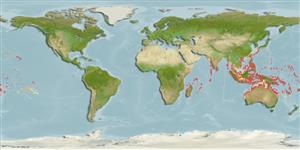Common names from other countries
>
Eupercaria/misc (Various families in series Eupercaria) >
Caesionidae (Fusiliers) > Caesioninae
Etymology: Pterocaesio: Greek, pteron = wing, fin + Latin, caesius = blue grey (Ref. 45335).
Eponymy: Professor John C Marr was head of the South Pacific Fishery Investigations of the US Fish and Wildlife Service. [...] (Ref. 128868), visit book page.
More on author: Schultz.
Environment: milieu / climate zone / пределы глубины / distribution range
экология
морской ассоциированный с рифами; немигрирующий; пределы глубины 1 - 30 m (Ref. 58018), usually ? - 10 m (Ref. 89972). Tropical; 34°N - 31°S, 39°E - 133°W (Ref. 402)
Indo-Pacific: East Africa, not including the Red Sea or the Arabian (Persian) Gulf, to the Marquesas Islands.
Size / Вес / Возраст
половая зрелость: Lm ? range ? - ? cm
Max length : 35.0 cm TL самец/пол неопределен; (Ref. 402)
колючие лучи спинного плавника (общее число) : 10 - 11; членистые (мягкие) лучи спинного плавника (общее число) : 14 - 16; колючие лучи анального плавника: 3; членистые (мягкие) лучи анального плавника: 11 - 13. Upper body blue to greenish, lower whitish. 4-6 cheek scales; 24-32 predorsal rays; scaled dorsal and anal fins. Upper peduncular scale rows usually 12 or 13 (12-14); lower peduncular scale rows usually 16 or 17 (15-17). Post maxillary processes 2; posterior end of maxilla tapered. The process on ventrolateral surface of basioccipital for attachment of Baudelot's ligament not extending beyond a horizontal with condyle's rim (Ref. 1723). Caudal fin lobes with dark tips. Head length 3.0-3.7 in SL; body depth 3.4-4.6 in SL (Ref. 90102).
Body shape (shape guide): fusiform / normal; Cross section: compressed.
Ranges widely around coral reefs (Ref. 58652) and appears to prefer clear waters of oceanic islands or reefs far from large land masses. Feeds on zooplankton in midwater aggregations. Oviparous, with numerous, small pelagic eggs (Ref. 402). Also caught by drive-in nets. Used as tuna baitfish.
Life cycle and mating behavior
половая зрелость | размножение | нерест | икра | Fecundity | личинки
Carpenter, K.E., 1987. Revision of the Indo-Pacific fish family Caesionidae (Lutjanoidea), with descriptions of five new species. Indo-Pac. Fish. (15):56 p. (Ref. 1723)
Статус Красного Списка МСОП (Ref. 130435: Version 2025-1)
Угроза для людей
Harmless
Использование человеком
рыболовство: не имеет хозяйственного значения; наживка: occasionally
дополнительная информация
инструменты
Специальные отчеты
Скачать в формате XML
ресурсы в Интернет
Estimates based on models
Preferred temperature (ссылка
123201): 25.2 - 29.3, mean 28.5 °C (based on 3174 cells).
Phylogenetic diversity index (ссылка
82804): PD
50 = 0.5002 [Uniqueness, from 0.5 = low to 2.0 = high].
Bayesian length-weight: a=0.01072 (0.00469 - 0.02447), b=3.11 (2.93 - 3.29), in cm total length, based on LWR estimates for this Genus-body shape (Ref.
93245).
Trophic level (ссылка
69278): 3.4 ±0.45 se; based on food items.
устойчивость к внешним воздействиям (ссылка
120179): высокий, минимальное время удвоения популяции до 15 месяцев (Preliminary K or Fecundity.).
Fishing Vulnerability (Ref.
59153): Low vulnerability (25 of 100).
🛈
Nutrients (Ref.
124155): Calcium = 60.6 [39.7, 90.7] mg/100g; Iron = 0.746 [0.488, 1.094] mg/100g; Protein = 19.1 [18.1, 20.0] %; Omega3 = 0.134 [0.092, 0.195] g/100g; Selenium = 29.3 [18.5, 50.1] μg/100g; VitaminA = 103 [42, 258] μg/100g; Zinc = 1.16 [0.84, 1.55] mg/100g (wet weight);
